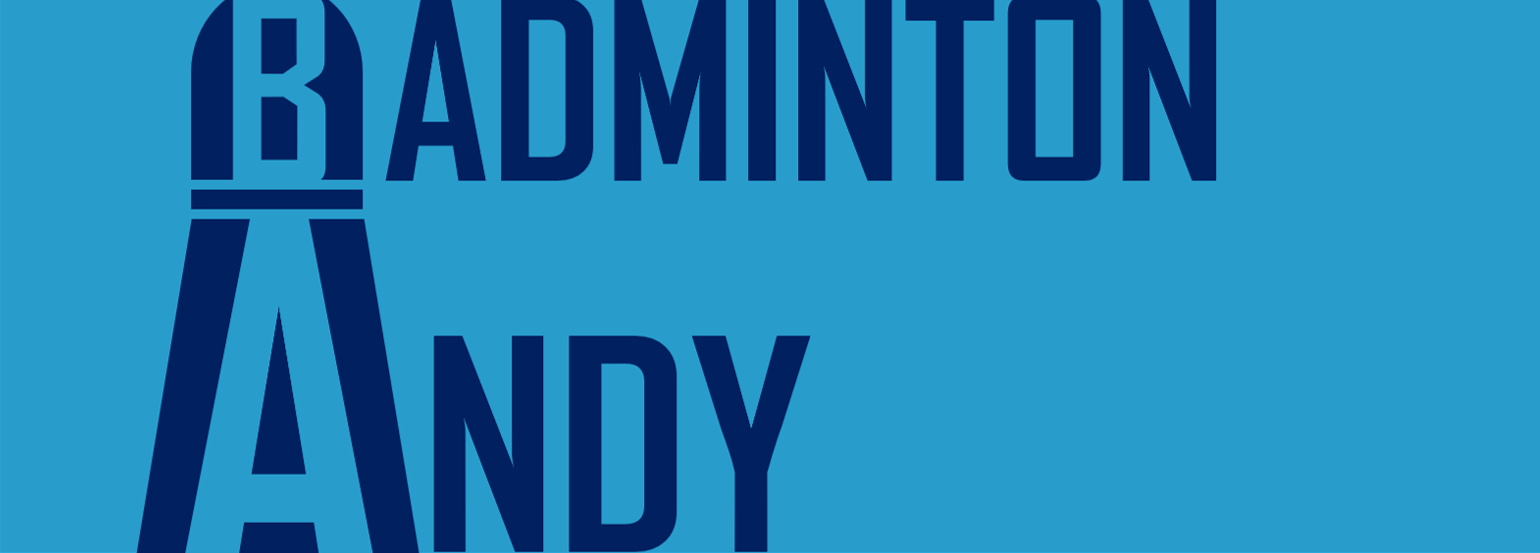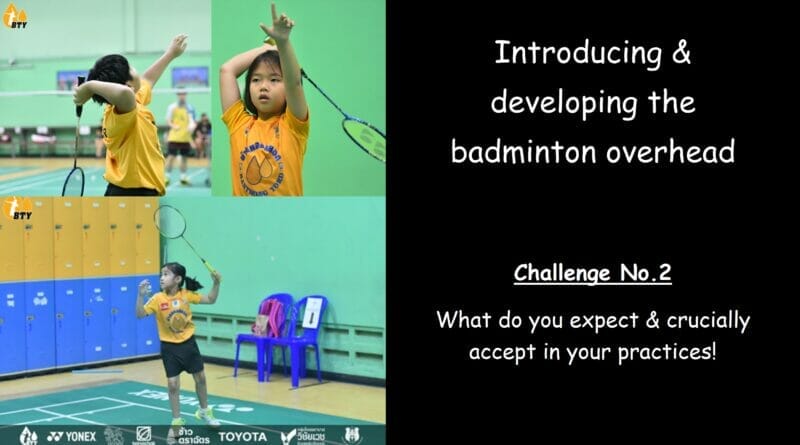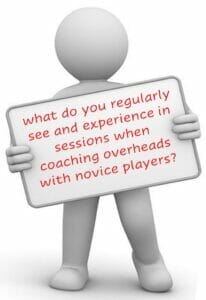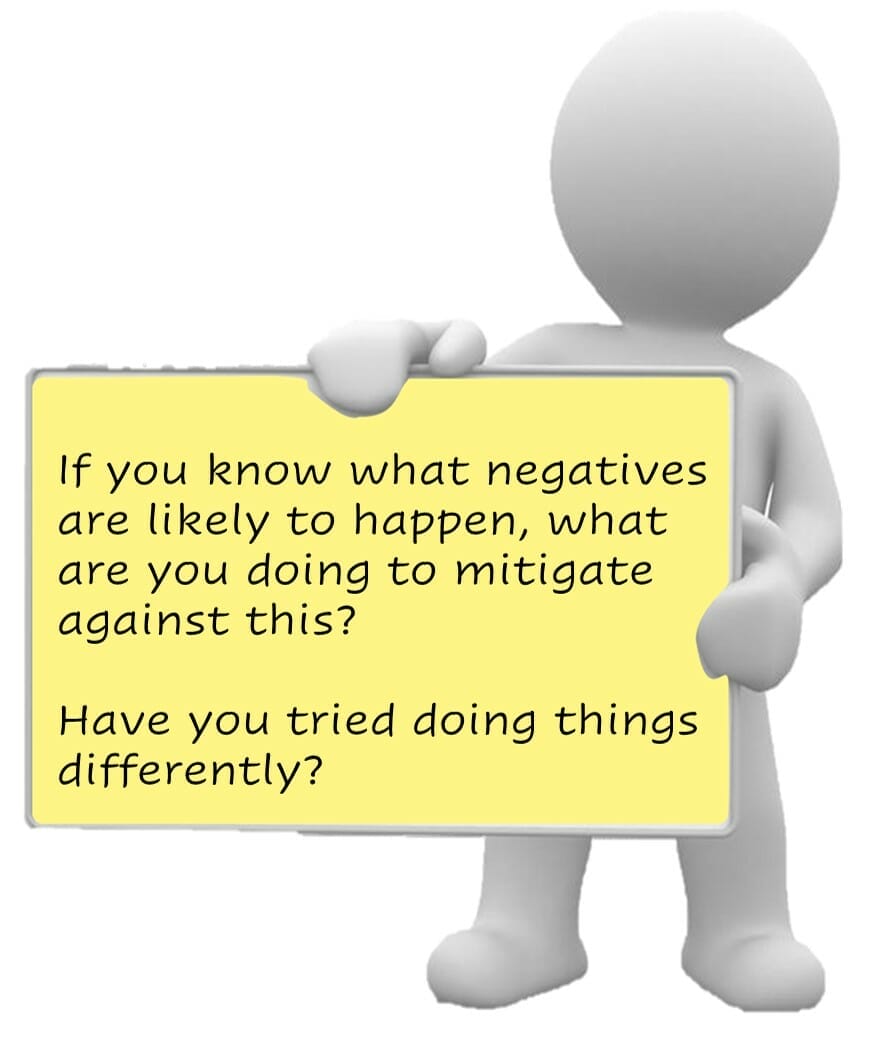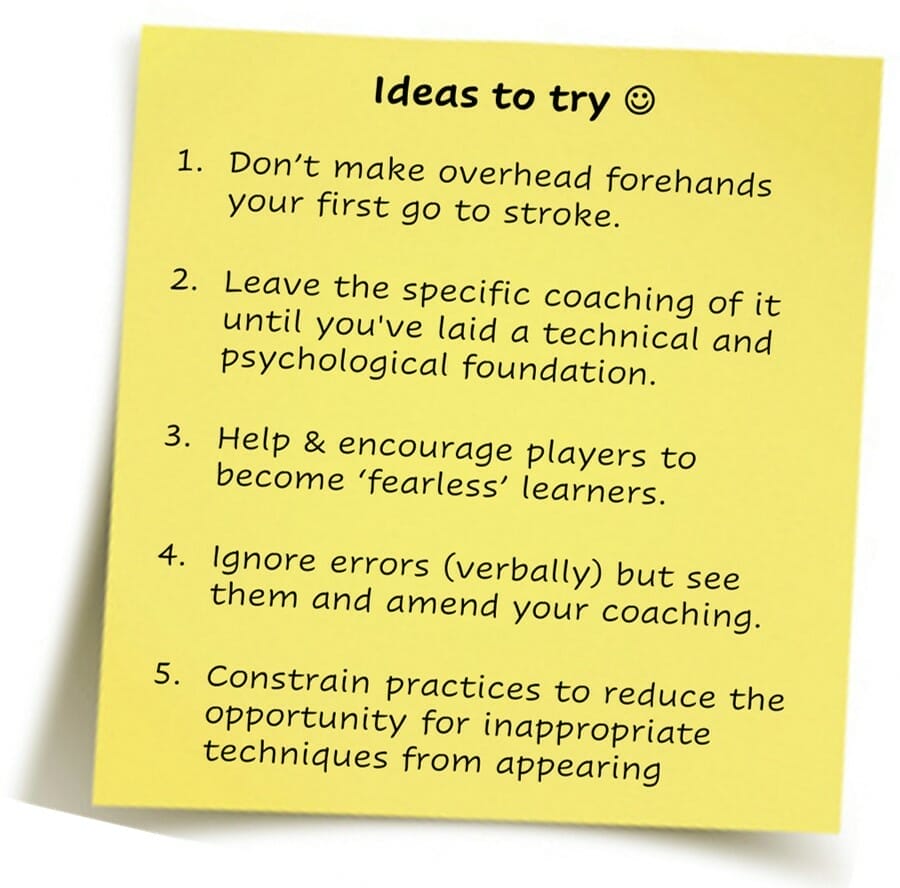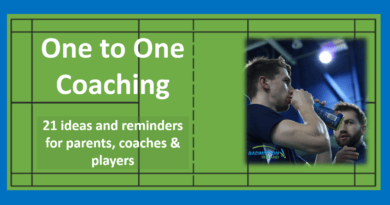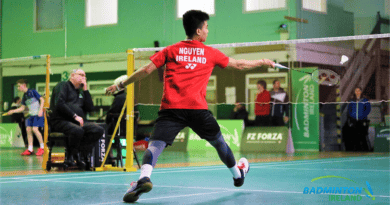Introducing the badminton overhead – Challenge No. 2
What would you expect to happen in any beginner overhead practice?
There are many challenges waiting for players and coaches
Some have negative outcomes, but crucially many coaches continue regardless
I asked some coaching friends what they expected – all were negatives
We discussed if they could be avoided
We decided to try and help coaches who work with beginner players when developing a badminton overhead forehand. The information examines the challenges that we believe most coaches face when first introducing the overhead, especially young players who are new to the sport.
We identified 5 aspects (unfortunately all negatives) that we expected to happen when coaching badminton overhead.
Crucially, we all seemed to accept that they would be present.
We then started to discuss if it was possible to avoid them rather than just accepting that they would happen. Shouldn’t we plan to avoid the negative outcomes if we knew that there was a likelihood of them appearing?
My aim is to give you ideas to help make the learning a little easier and to create more smiles than struggles in your coaching sessions 🙂
Do you already know some of the challenges that you will face?
– – – – – – – – – – – – – – – –
Some background information

If you haven’t read the introductory post I recommend you click here or this image.
It outlines the challenges coaches face and why I believe that this movement also attracts the most coaching problems. Maybe even more than an overhead backhand.
There is also an insight into what happened when I spoke with 2 other coaches about these challenges and how at times, we disagreed! I’ve outlined some of the thoughts we had during our conversation.
– – – – – – – – – – – – – – – – – –
I asked coaches what they expected
The things they expect & crucially accepted
Aspects to consider
A possible solution
Things to think about and maybe try
– – – – – – – – – – – – – – – –
What do you expect to happen when introducing the overhead forehand
I asked some coaches what they expected to happen in sessions focused when helping beginners starting to play overhead forehands. What did they regularly see and think was possible to predict?
After a short discussion, we made a list, most points seemed to highlight negative aspects 🙁
Worryingly, we agreed that coaches (including us) continued to coach as we did even with the knowledge that these aspects would probably happen.
We knew the problem that we’d face and the challenges the players would experience, but we carried on regardless.
It didn’t seem a sensible thing to do, yet we did it.
What do you expect when you are coaching overheads with novice players?
“the things you regularly see and experience in sessions when coaching overheads with novice players”
(For a definition, imagine players who have only played 0 – 2 yrs aged between 6 – 10 yrs old)
– – – – – – – – – – – – – – – –
The things coaches expect and crucially accept
- Inappropriate technical errors appearing – pan-handle grip, throwing issues, footwork problems.
- Slow learning/development rates – especially when compared to other below should strokes (net, flick, serves, etc)
- Variable success -players missing the shuttle, unable to direct or control accuracy, success rates lower than 50%
- Confidence & motivation issues – players becoming frustrated at the lack of success
- Self-correction – players creating solutions in order to ‘succeed’. Solutions that hindered future development
Do you see these 5 issues when you coach novice players?
Maybe you see others that you think should be added to the list
– – – – – – – – – – – – – – – –
Consider this
It could be argued that there is a possibility of the 5 challenging aspects above appearing in any stroke or movement being developed. However, the impact on the development of this important stroke should cause you concern.
How much thought have you given to why you do what you do with beginner players or are you a stand-off coach and ‘”just let them experience things for themselves”?
Changing an inappropriate or limiting technique in the future is difficult
It’s certainly not impossible to change a beginner’s technique, but it’s time-consuming and challenging for both the player and the coach. So why would we do something in our coaching that is likely to cause players ( and coaches) future problems, as well as those immediately in front of us?
I’d rather coaches not become an expert in error correction, rather they become skilled at error prevention.
However, it could be that our experience is hindering and not helping. If this is all you have ever seen when coaching overheads why would you change?
You expect problems to occur and they do, it’s what you experienced previously. Plus you may have become an ‘expert’ in correcting overhead forehand problems! 🙂
Or, worse maybe, you expect problems and when they appear just ignore them and carry on repeating the same practices and giving the same information.
I’m sure that eventually players will progress, and everyone will ‘improve’ in some respect. Especially if the challenge of the practice or the goals are lowered to accommodate the lesser, inefficient techniques. But, the goal isn’t to reduce expectations.
Imagine if by changing how and when you introduce the task of specifically developing overhead you could reduce the likelihood of the problems described in the 5 points above. Plus imagine giving players confidence in their ability to work through challenges that they will face.
If we know that these challenges or issues (I guess it depends on how you see them) are present and likely to occur then should we not try to avoid them, or at least mitigate them and reduce their impact?
For me, the two that have the greatest potential for impact are points 1 and 5. They both concern inappropriate technical errors appearing that may seem to work, but create future limitations to development.
It concerns me that coaches accept this situation,
they expect these issues/problems to occur and they do!!
– – – – – – – – – – – – – – – –
A possible solution
If you are currently struggling with the issues detailed here or have just accepted that they arise when starting to coach overheads I want to offer some ideas for you to consider.
I’m not sure how you will react to each suggestion, that’s up to you and out of my control. Maybe they will ‘prickle’ your beliefs and cause a challenge to your thinking.
Don’t start coaching overheads with beginner players start with other strokes,
create experiences (through practice) that influence and aid in fh overhead development
– – – – – – – – – – – – – – – –
Things to think about and maybe try
- Why not leave overheads until after players have experienced other strokes? Think about all the ‘below-shoulder-strokes’ that you could coach and how this type of player would respond. Use specific well-chosen practices and different methodologies to lay a foundation for overhead, coach with intent!
- Consider how many of the technical elements of ‘below-shoulder-strokes’ are similar to each other, link together, make practice easier to progress, and can be easily into mini-games / challenges.
- Help players become aware of how learning happens. Don’t tell them this, let them experience it and get them to explain their thoughts back to you when the time is appropriate.
- Create a style of coaching that encourages players to become ‘fearless’ and willing to try, even if they fail. When coaching, sometimes appear to ignore errors and enthuse about effort and application. Store the information provided by the players’ failures and amend your practice and style, but without telling them.
- Develop trust and ‘confidence in the coach’ by the way your deliberately design and layer your practices. Become an expert in knowing why you do what you do.
- Set many practices that appear challenging (but are only just above the players’ specific level) and that constrain the opportunity for inappropriate techniques to form (maybe easier said than done!)
- Doing these things will help with
- how to hold (grip) the racket
- develop a throwing action
- develop handcocking
- instil a fearless approach to learning
- establish confidence in the coach and the practice progress
If this sounds too radical for you, then consider why you feel like that
I had a similar experience when I was first introduced to doing other practices before introducing the overhead
– – – – – – – – – – – – – – – –
If you recognise these challenges or some of them, you may already have strategies to either avoid them or reduce the impact of each.
Therefore I’d ask, are you willing to write something about your experiences and share your thoughts?
The badminton overhead forehand is a critical movement/stroke so the best we can do is combine all our opinions.
